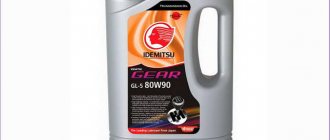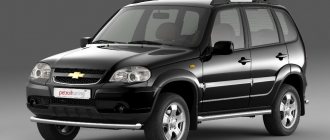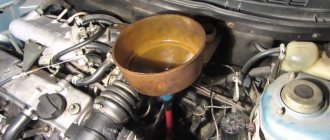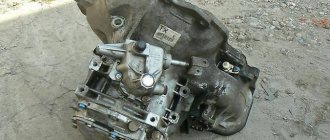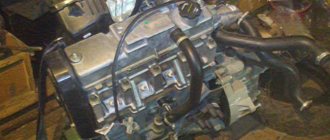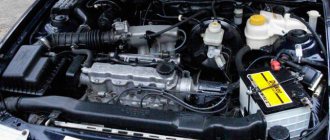DSG-7 is a seven-speed robotic gearbox widely used in Volkswagen cars. This type of transmission combines elements of an automatic transmission and a manual transmission, but is not their direct analogue due to the presence of a double-disc clutch. This allows the DSG robot to change gears faster and at the same time save fuel consumption compared to a classic automatic.
However, the fast nature of the operation is one of the reasons for regular maintenance of such a gearbox, which has a rather fragile design that is not resistant to overloads. Maintenance should first of all mean timely replacement of the oil and oil filter. The article also discusses issues related to the required volume of oil and its suitable analogues.
The most popular articles on the site:
- How often should you change engine oil?
- Oil 5w30 and 5w40 what is the difference
- What oil to pour into the engine in winter and summer
- How long does it take to change the automatic transmission oil?
How is DSG-7 better than a regular automatic transmission?
Only a timely oil change in the DSG-7 gearbox will allow you to appreciate the undeniable advantages of this transmission over a classic automatic transmission. Its key advantage is smoother and faster gear shifting without loss of power between gears. This is due to the two-shaft design, that is, the robot body includes two gearboxes at once. The main difference from a conventional manual transmission is the use of a two-shaft arrangement for even and odd gears.
How the DSG-7 DQ200 gearbox works. Pros and cons, tips for using the box.
It is this design that allows you to change gears faster, because while engaging the first gear, preparations are already underway for engaging the second, and so on. When moving to the next speed, the clutch of the first shaft opens, and the second clutch instantly picks up the torque. Thus, VW engineers managed to achieve smooth and quick shifts without loss of power.
What is a DSG transmission?
Like a classic torque converter automatic, the robotic DSG uses fixed gear ratios to ensure that the gearbox operates at the most efficient engine speed depending on the selected speed.
But unlike a standard automatic transmission (automatic transmission), the robotic version (manual transmission) simultaneously combines two sets of gears, in one of them the speeds are even (2, 4 and 6), and in the other - odd (1, 3 and 5, more maybe the seventh stage).
There are also two input shafts, and each set has its own clutch, this is done to ensure quick selection of gear engagement and a smooth transition between shifts.
This type of gearbox combines the principles of operation of “mechanics” and “automatic”, and is, as it were, a middle link between them.
Like a manual transmission or an automatic transmission, the DSG robot has gears of different sizes, the largest of which provide the lowest (first) gear, in which the car will move slowest.
The robotic gearbox offers optimal ease of driving - there are only two pedals in the cabin, like on a car with an automatic transmission (brake and gas), and shifting is controlled electronically.
At the same time, the DSG manual transmission itself, in its “filling”, is a conventional mechanical transmission, in which some gears of different sizes are in constant mesh, gear selection is carried out through clutches, and there are synchronizers and forks.
What types of DSG-7 are there?
- DSG7-0B5 (DL501) – 7-speed robot with wet clutch. It is installed on cars with a longitudinal internal combustion engine, as well as front-wheel drive or all-wheel drive.
- DSG7-0BT/0BH (DQ500) is a 7-speed preselective gearbox with a wet clutch, designed for installation in cars with a transverse internal combustion engine, as well as front-wheel drive or all-wheel drive. Suitable for engines with torque up to 600 N/m
- DSG7-0AM/0CW (DQ200) - a 7-speed robot with a dry clutch, which is installed on inexpensive VW cars with front-wheel drive and low-power 1.2-1.4 liter engines with a torque of up to 250 N/m
How is DSG7 different?
VAG cars are equipped with two main types of DSG transmissions. Some of them have a wet clutch, while others have a dry clutch. The latter are called DSG7. Their design does not require a hydraulic clutch cooling system. For this reason, such a transmission does not tolerate work in traffic jams and congestion: the lack of incoming air flow often leads to overheating and failure.
A distinctive feature of this model is the limitation of the torque of the motors used. They are equipped with the concern's cars, whose maximum thrust is within 250 Nm.
How to easily and quickly update the lubricant in a gearbox?
When to change the oil: what the manufacturer recommends
According to the manufacturer, the factory fluid in the DSG-7 robotic box is designed for the entire period of operation of the vehicle. In other words, the replacement interval in this case can reach 100 thousand km or even more. Thus, if you follow the advice of Volkswagen, then you should only change the oil when purchasing a used car with the specified mileage. In this case, you need to ask the previous owner about the conditions under which the car was operated. This is important because in Russian realities the load on the DSG robot can be unpredictable, and therefore there is a need for earlier replacement.
How to drain old oil
Draining transmission fluid is easy. To do this, you will need a pit or a lift, containers for mining and hexagons for 6 and 10. After removing the protection, the lower part of the box and the drain plugs of the control unit and the box itself become visible.
You need to unscrew the plugs one by one and carefully drain all the liquid into pre-prepared containers. It is advisable to replace the plugs with new ones. Their tightening torque is 30 Nm. At this point, the oil drainage is complete, the protection can be returned to its place and proceed to the next stage.
How to extend the life of DSG-7
Knowing about the shortcomings of DSG, many caring car enthusiasts are wondering how to increase the service life of a robotic gearbox so that it pleases its owner with fast and clear shifts for as long as possible. In this case, you can do the following: simply reduce the oil change interval to 40 or 30 thousand km, so that it does not have time to deteriorate under any circumstances. This is especially true for harsh conditions of use, when you have to frequently change gears in city traffic jams.
Signs of deteriorating DSG performance due to bad oil
- extraneous sounds
- unclear gear engagement
- metallic clang
- kicks, jerks and vibrations
- lack of traction during acceleration
Signs of deterioration in oil quality in the DSG box
If the above symptoms are detected, it is necessary to check the condition of the transmission fluid.
- Remove the engine protection, wipe the gearbox in the area of the drain plugs
- Unscrew the drain plug and drain the waste fluid
- Assess the condition of the oil: - amber-yellow color does not give cause for concern - light or dark brown color indicates the presence of wear products and deterioration in oil quality
What negatively affects the reliability of DSG-7 and the shelf life of the oil
- constant movement around the city with traffic lights
- sudden throttle changes and frequent shifts
- using the wrong oil
- frequent slipping
- overheating of the box due to high load
- transportation of heavy loads and semi-trailers
- unqualified maintenance with deep intervention in the DSG design
Characteristic disadvantages and malfunctions of the DSG-6 preselective box
The transverse six-speed gearbox DSG-6, also known as the DQ250, is already a fairly old gearbox, replaced by new versions, but it is still found on many vehicles that are currently in use.
The most important disadvantages of this transmission are considered to be increased fuel consumption and jerking of the car when changing gears.
Also, during operation, vibration, extraneous noise in the “robot” area, clanging when starting/stopping the engine or idling, and deterioration in dynamics may appear over time.
Typical failures of the DSG-6 are:
- wear of the solenoids in the mechatronics responsible for regulating the pressure; with such a malfunction, jerks appear during speed changes;
- wear of the gearbox bearings, including on the input shaft; a sign of a problem is increased noise when accelerating or sharp braking. If the differential bearings are worn out, the noise increases when cornering;
- problems in the electrical part of the mechatronic, due to which the manual transmission may go into emergency mode, and the electronic unit may generate system errors. Repairing the ECU does not always solve the problem; replacing the entire mechatronics often helps;
- Dual mass flywheel (DMF) damper springs are weakened or broken. If such a problem occurs, a clanging sound occurs, vibrations begin when the engine starts and at idle.
The six-speed gearbox is generally considered a more reliable unit than the DSG-7 due to the “wet” clutch, and since 2003 Volkswagen specialists have had time to work on mistakes and improve the transmission.
During its existence, the “preselective” has undergone significant modernization twice: first in 2009, and then in 2013, when the automaker slightly changed the gearbox housing and updated the filters.
New software versions were also periodically released, and the friction unit was updated four times.
Subject to operating conditions and proper maintenance, the DQ250 gearbox can last up to 150-200 thousand km or more without repair, although the first twitching may appear at 50 thousand kilometers.
Here, a lot depends not only on road conditions and timely, high-quality maintenance, but also on the driving style and accuracy of the driver.
The average life of a “wet” clutch on a 6-speed manual transmission is 120,000 km; the mechatronics can become clogged with metal shavings closer to one hundred thousand kilometers traveled.
Although it is recommended to change the oil every 60 thousand km, more frequent maintenance will not hurt; many car owners of cars with a robotic gearbox recommend adhering to the 40 thousand km interval.
What is DSG adaptation and when should it be carried out?
If, over time, jerks and jolts occur in the robotic box when moving, then it’s time to make an adaptation. The need for this procedure arises due to wear and deterioration in the efficiency of the clutch, which causes a decrease in the smoothness of gear shifting and the appearance of jerking. This ailment can be eliminated with the help of adaptation, which must be carried out after 15 thousand km or even earlier if the car is constantly used in a city with traffic jams. Ideally, you should not wait for shocks to appear and stick to an interval of 10-15 thousand km. Modern versions of the DSG are equipped with special travel sensors for the clutch fork and pulleys so that the electronics themselves adapt as the clutch wears out, regardless of the mileage of 10 or 15 thousand.
How to make an adaptation using the example of DSG DQ200
Adaptation is best done at a service center using a computer program, but thrifty owners of used cars often resort to a simplified method of DSG adaptation:
- Drive 10-15 km to warm up the engine and gearbox
- Turn off the engine and turn the key to activate the dashboard (in some cars, adaptation can be carried out with the ignition off)
- Lower the door window and press the gas until the kick-down is activated so that an audible click appears in the transmission housing
- Hold the accelerator for 40 seconds
- Release the pedal and remove the ignition key
- Reconnect the chain, start the engine and start driving.
How to prepare a car for work?
Before starting the replacement, it is important to warm up the transmission thoroughly. To do this, it is better to make a preliminary trip, during which the oil inside will become warm
In this state, the liquid becomes more fluid and will flow much more easily and quickly from the shafts and gears located inside during draining.
If in the summer you can do without a long preheating procedure, then in the winter it will be difficult to drain the lubricant from the gearbox of a car that has been standing in the cold for even less than an hour. Warming up can be accelerated by frequent starts and stops; this mode loads the transmission of this type most heavily and quickly.
What oil to use. Oil volume
Oil in DSG7 0B5/DL501: what kind and how much, analogues
For the DSG7 0B5/DL501 robot, original synthetic oil VAG G 055 532 A2 or G052 529 A2 is recommended.
The total volume of oil poured is 7 liters during maintenance with replacement of the internal filter and pan gasket.
Oil filter: internal – 0B5325429E, external (main) – 0B5325330A
Drain plug O-ring: N0138275
Pan gasket: 0B5321371F
Analogs of original VW fluids are SWAG 30 93 2380, Pentosin FFL-2 4008849174216 and Liqui Moly 8100.
Oil in DSG7 0BH, 0BT/DQ500: what kind and how much, analogues
The most common versions of this gearbox model are 0BH and 0BT. They are designed for certain Volkswagen vehicles, but they are no different in terms of service. Therefore, for the entire DQ500 family, the manufacturer recommends the original fluid G052182A2
The standard volume for changing the oil in the DQ500 box is 6 liters , and the total volume during a complete change increases to 7-7.2 liters
Oil filter – 0BH325183B
Filter gasket – N91084501
Gasket for drain plug – N0438092
Gasket for filler plug – N0138132
Analogues of VAG branded oil:
- Ravenol DCT/DSG Getriebe Fluid 4014835712515
- Pentosin FFL-2 4008849174216
- Fuchs titan DCTF 600880095
- Liqui Moly Doppelkupplungsgetriebe-Oil 8100 3640
- REDLine DCTF Dual Clutch Transmission Fluid 31004
- Total Fluidmatic DCT MV 198712
- Addinol ATF DCT 4014766073303
- Wolf ECotech DSG Fluid 8308604
Oil for DSG-7 DQ200 (0AM, 0CW): what and how much
The 7-speed DQ200 robot has a mechatronics circuit that is separate from the gearbox circuit. Thus, this box will require two working fluids: transmission G055512A2 and hydraulic G00400M2.
The volume of hydraulic oil poured into the mechatronics unit is 0.9 liters, and the box itself requires 1.7 liters of transmission fluid. There is no need to replace filters (neither external nor internal).
Process steps
First of all, the machine is lifted on a lift or installed on a pit. It is recommended to install the gearbox selector in parking. Next, unscrew the drain plug on the gearbox housing. First, a liter of liquid will pour out of the box. Then you need to unscrew the control tube - about five more liters will flow out. If chips leak out along with the oil, then this is a reason to contact a service center to repair the box.
Next, the filter is replaced. On many cars (including Skoda) with DSG-6 the filter is located higher. To access it, you need to remove the battery along with the platform, the air filter housing and the air ducts. Then you can unscrew the filter.
Advice from motorists on changing the oil
- Use only factory-recommended fluid or an equivalent that meets factory specifications and requirements. Any deviation even according to one of the standards can negatively affect the technical condition of the unit
- It is highly undesirable to change the DSG oil yourself, especially if the car is under warranty. Moreover, this requires deep intervention in the design of the gearbox. In the absence of the necessary experience and knowledge, there is a high probability of damage to the unit and this can lead to expensive repairs to the box
- If you want to change the oil yourself, it is important to keep in mind that the replacement method may vary depending on the type of clutch - wet or dry. In other words, each DSG-7 model requires its own replacement method
- When changing the oil, it is necessary to change the gaskets and sealing elements so that leaks do not occur in the future. These consumables have the original part number, which can be found in the instruction manual or fan forums on the Internet
- It is necessary to take into account not only the factory oil change interval, but also based on operating conditions, since due to possible heavy loads it will be necessary to reduce the schedule. If jerks and other signs of deterioration in DSG performance appear, you must immediately find out the reason for this behavior of the box. To do this, you should contact a car service center as soon as possible for subsequent diagnostics, dismantling, disassembling and repair of the gearbox, if necessary.
- The transmission oil needs to be replaced urgently if it contains metal shavings, soot and other wear products. Thanks to timely replacement, jerks and shocks can be avoided.
- When changing the oil, you need to check the correct volume of fluid, which may differ depending on the DSG-7 model. The oil level should not be lower or higher than normal. Ideally, it is better to buy mini canisters with a volume of 1 liter so as not to encounter unjustified costs
Filling with new oil
To fill the oil, you need to remove the cover and remove the starter, battery and its platform. This is quite difficult and time-consuming, which is why many auto mechanics prefer to fill the oil through the breather. This is much faster, although it requires some skill.
The mechatronics breather is located near the starter. To remove it, just place a 16mm wrench under it and carefully loosen the plastic plug. To add oil, you will need a hose with a diameter of 8 mm, a large-volume syringe or a funnel. The tube is connected to the hole, and a syringe with oil is attached to the other end. Transmission fluid is slowly poured into the mechatronics control unit. After 1 liter is filled, the hose is removed and the plug is put in place.
To gain access to the breather hole of the box itself, the gear selector must be moved to the “P” position. If this is not done, access will be limited by the lever. The gearbox breather plug can be easily removed by hand. The technology for filling oil is the same as for the control unit, but the gearbox will require 1.9 liters of transmission fluid. It is better to drain the oil into a separate container in order to accurately measure its volume and pour exactly the same amount. The breather plug is reinstalled and the car is ready to hit the road again.
Box DSG-7 DQ500: which models are installed on
Audi
- Q3 2.0 TFSI Quattro 170-220 l. With.
- Q3 2.0 TDI 140 l. With.
- Q3 2.0 TDI Quattro 150-184 l. With.
- RS Q3 2.5 TFSI Quattro 340-367 l. With.
- RS Q3 2.5 TFSI Quattro 400 l. With.
- TT RS 2.5 TFSI Quattro 400 l. With.
Volkswagen
- Transporter 2.0 TDI 140-204 l. With.
- Transporter 2.0 TDI 4Motion 150-204 l. With.
- Multivan 2.0 TDI 140-204 l. With.
- Multivan 2.0 TDI 4Motion 140-204 l. With.
- Caravelle 2.0 TDI 140-204 l. With.
- Caravelle 2.0 TDI 4Motion 140-204 l. With.
- Tiguan 2.0 TDI 4Motion 177-184 l. With.
- Tiguan 2.0 TSI R-Line 4Motion 210 l. With.
- Tiguan II 2.0 TDI 4Motion 150-180-hp With.
- Tiguan II 4Motion 180-220 HP With.
- Passat B8 2.0 TDI SCR 4Motion BlueMotion 240 l. With.
Skoda
- Kodiaq 2.0 TDI 4x4 150 l. With.
- Kodiaq 2.0 TSI 4×4 180 l. With.
Box DSG-7 DQ200: which models are installed on
Volkswagen
- Bettle A5 1.2 (105 hp) and 1.4 (160 hp)
- Jetta 6 1.4 122 l. With.
- Passat B6 1.4 122 l. With.
- Passat B6 1.8 152 l. With.
- Passat B8 1.4 (125-150 hp) and 1.8 (180 hp)
- Polo 5 1.2 (90 hp), 1.4 (110 hp)
- Golf Plus 2 1.2 (105 hp), 1.4 (122 hp), 1.6 (106 hp)
- Scirocco 3 1.4 (122-166 hp)
- Touran 1.6 TDI
Skoda
- Fabia RS 2 1.4 180 l. With.
- Octavia 1.4, 1.8 TSI
- Rapid 1.4 TSI
- Supereb 2.0 TDI (front-wheel drive and all-wheel drive)
- Yeti 1.2 (105 hp), 1.4 (122 hp)
- Octavia A7 1.8 180 l. With.
Audi
- A3 8V 1.4 TFSI 122 l. With.
- A1 8×4 122 l. With.
- TT0
Seat
- Altea 1.6 TDI
- Leon 2 1.8 (1P – until 2013)
- Toledo 4TSI
DSG mechatronics: what is it?
Mechatronics is an electronic-hydraulic unit that is actively used in the DSG preselective gearbox on VAG models. A similar device can also be installed on cars from other manufacturers. This element is located in the robotic gearbox housing.
If we talk about the design, mechatronics is an ECU and a number of electronic-hydraulic components that are located in a single housing. Also, a large number of different automatic transmission sensors are connected to the mechatronics, which makes it possible to achieve coordinated and precise operation of an automatic transmission of this type.
The sensors send data to the electronic “brain” (oil temperature, pressure, input/output shaft speed, etc.). Then the electronics analyzes the received data, after which control signals are generated (in accordance with the program “hardwired” into the memory) and sends them to the hydraulic unit. Next, the hydraulic circuit is activated in the valve body under the control of the ECU.
At the same time, normal operation of mechatronics is possible only if all components are in good condition (there are no problems with electrical, hydraulics and mechanics). It becomes clear that the mechatronic unit actually controls the operation of the robotic gearbox.
Based on signals received from sensors about the state and operating modes of all vehicle systems, the unit selects the optimal gear shift moment and also independently regulates the shift process itself.
In parallel, the mechatronics controls the operation of the friction clutch, and is also in close contact with other units that are part of the ECM on a particular vehicle. It should be remembered that certain mechatronic malfunctions (unlike similar cases with “classic” automatic transmissions) can lead to the car suddenly being unable to continue moving.
In other words, any malfunctions in the operation of the preselective box are grounds for stopping further operation of the vehicle and conducting in-depth professional diagnostics. Otherwise, the clutches may open while driving, as well as transmission breakdowns.
You also need to remember that the mechatronics DSG (electronic transmission control unit) receives signals that tell it the operating parameters of the engine, clutch, and servos. This means that, for example, problems with the internal combustion engine can also affect the operation of the box.
Taking into account the fact that the automatic transmission ECU and the gearboxes themselves are constantly being improved, the logic of operation is becoming more and more complex. At the initial stage, the first automatic transmissions had read-only memory units (ROM), where microprograms were recorded. At the same time, a serious disadvantage was that it was not possible to change and correct the recorded data.
As a result, a car with an automatic transmission could not be separately adapted for operating conditions other than those previously recorded in the ECU memory. Subsequently, the boxes became more advanced; ROMs without the ability to make changes to the software were quickly abandoned in favor of solutions with the ability to rewrite or adjust the software.
The possibility of flashing made it possible to flexibly adapt the automatic transmission ECU and mechatronics to various operating conditions. In practice, after the advent of DSG boxes, regular flashing and adaptation of the control unit (updating software and installing modified versions of the program) has become common practice.
To put it simply, such boxes are adaptive, and the algorithms themselves, by which mechatronics works and the transmission control process is carried out, are quite complex. You also need to take into account the fact that there are different versions of the DSG gearbox itself, which is installed on certain models, paired with different engines, etc.
It turns out that each type of DSG has a separate type of mechatronics unit, and they are often not interchangeable with each other. It can also be noted that several types of blocks were released at different times.
They have certain design differences, contain different versions of software in memory, and are designed to work with different engines and gearboxes, where the gear ratio is different. Moreover, only in some cases can mechatronics of one generation be successfully reprogrammed and installed on another vehicle.

